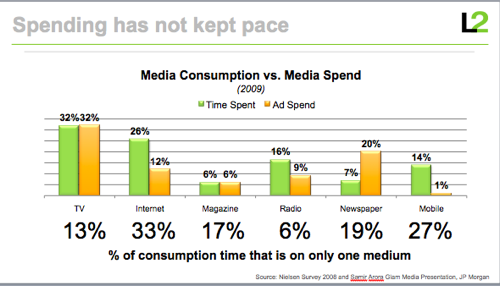Articles and News
SCOTT GALLOWAY TO JEWELRY INDUSTRY: YOU LAG! | June 01, 2011 (1 comment)

Carlsbad, CA—To no great surprise, experts agree the jewelry industry still is in the digital Dark Ages. In his presentation at GIA’s International Gemological Symposium, New York University business professor and digital marketing expert Scott Galloway of L2 Think Tank said when compared to other luxury product categories, the prestige jewelry and watch industry ranks at the bottom in terms of digital presence. His firm does the only brand audit that ranks digital performance of prestige brands, and surprisingly, even famous names like Rolex get very low marks for digital savvy, though he cited Tiffany as an example of a good jewelry website.
He cited a few reasons for the industry’s poor performance: it’s very fragmented, it’s got very few public companies and hence very few Wall Street analysts demanding to know what their digital strategy is, and it’s run by old men. The fashion industry, he said, still isn’t a star performer, but it’s pulled away from the jewelry industry at the bottom. Why? Fashion has a lot of female CEO’s in their 40’s and 50’s, who, even if they’re not entirely tech savvy themselves, have children who practically live online and they’re aware of the importance of social media and are bringing that awareness to their marketing strategy.
“This industry [jewelry and watch] is run by old white European men. They’re not the Internet generation; they’re the generation that wishes the Internet would go away,” he joked. But he said it’s long been obvious that the Internet is not going away and companies that don’t get a good strategy in place ASAP risk becoming obsolete themselves. And at that, the Web itself is dying as a marketing tool—now it’s all about social, mobile, and commerce. Having a website isn’t enough.
“Think of Facebook as a distinct market,” he said. “It’s practically a country of its own! You think China is the fastest-growing consumer market? No! It’s Facebook!” 50% of Facebook users are college educated, with household income over $50,000, he said. Furthermore, mobile marketing, shoppable video, and other advances are leaving traditional web marketing behind.

Scott Galloway presented this chart during his digital marketing session at GIA Symposium. The royal blue segment shows the growth of consumer time spent on Facebook, versus declining time spent on YouTube (pink), Google (purple), MSN (yellow), and Yahoo (green).
It’s not about carpet-bombing your message, or even about strategic bombing, he said. That’s the old model. The new model is engagement, meaning one on one, or, we’re about to go from carpet-bombing to hand-to-hand combat. Do you want to rent an audience—i.e., you have their attention when they’re reading your magazine or website—or do you want to own an audience that loves your brand, is passionate about your brand, talks up your brand? Vogue magazine, for example, has 1.3 million readers, while the English luxury brand Burberry has a direct relationship with five million followers, he said. As an aside, he pointed out that Burberry also has a female CEO.
He flashed a chart showing that only 66% of the 71 brands in L2’s Digital IQ Index have some form of social sharing. Only 4% have live chat, only 3% incorporate a “like” button, and not one employs user-generated reviews.

In this chart, Galloway illustrates how luxury brands' advertising spend (yellow bars) is disproportional to consumer media consumption (green bars) in a number of categories.
Often the fear of negative user reviews holds a company back from embracing a social strategy. That’s dead wrong, says Galloway.
“It’s happening already, you just don’t have a seat at the table,” he said. Negative reviews are not necessarily bad—aside from giving a company an opportunity to correct something it’s doing wrong, it lends credibility to the positive reviews. It’s been proven, he said, that a negative review rate between 5% and 20% actually tends to increase sales.
“Go online and post that your Chanel bag sucks and there’s going to be lots of conversation!”
Prestige companies tend to move very, very slowly, said Galloway. They’re far more likely to have created a luxury iPad cover (above, by Hermes) than they are to have actually embraced the opportunities an iPad represents. He likened it to a Faberge egg, which is placed in a glass display case and carefully guarded but nobody’s allowed to touch it.
“Prestige strategy is ready, aim, aim, aim, aim, fire. Successful digital marketers’ strategy is ready, fire, aim, fire, aim, fire, aim.” Take chances with digital, he said—it’s one thing to open a store in South Coast Plaza where you have to sign a five-year lease and the rent is high, but in digital the exit costs are low and you can afford to fail, even a few times.
His sentiments almost exactly echoed the words of luxury market expert Pamela Danziger, who told The Centurion last week that e-commerce is a requirement, no longer an option. “Do not make the customer window-shop online,” she warned. Luxury customers want what they want when they want it, she said.
Fear is getting in the way of being relevant for this industry, said Galloway. If you want to be relevant in a b2c world, you have to be on Facebook. He acknowledges there is a cultural divide, but it has to be bridged. Don’t turn into the professor who was great in the ‘80s but hasn’t changed since then.
“Older people want to be anonymous. Get over it!” he barked. Gen Y is remarkably different. The entire prestige industry was supported by the Boomer generation with a fire hose of cash, but now that hose is flaccid. Yes, the economy is coming back, and yes, Boomers still have money, but they’re also facing retirement and their priorities are shifting.
But Galloway admitted that despite the low exit costs that encourage digital risk-taking, it’s not easy. Excusing himself in advance, he said, “this [expletive's] not checkers, it’s chess.” He suggested reading online newsletters from sources like Mashable.com, or his own L2 Think Tank, and emulating brands whose strategy you admire. There are companies that will manage your Facebook presence, too, if you’re not ready to take it on yourself. And remember that you don’t necessarily get a return on investment from one individual digital element, but taken as a whole, it brands your company as innovative. He again cited Burberry, a brand that had grown stale and whose luxury image was getting tarnished from overexposure of its iconic plaid design. It reined in licensing, added a cutting-edge new luxury division called Burberry Prorsum, embraced digital technology and has emerged as a clear leader in that arena.
“In jewelry, why not you?” he said.







